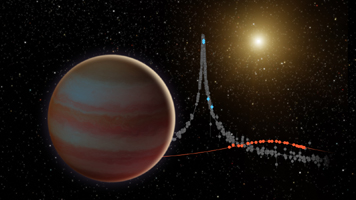
Figure 1
Click on the image for larger versionThis illustration depicts a newly discovered brown dwarf, an object that weighs in somewhere between our solar system's most massive planet (Jupiter) and the least-massive-known star. This brown dwarf, dubbed OGLE-2015-BLG-1319, interests astronomers because it may fall in the "desert" of brown dwarfs. Scientists have found that, for stars roughly the mass of our sun, less than 1 percent have a brown dwarf orbiting within 3 AU (1 AU is the distance between Earth and the sun).
This brown dwarf was discovered when it and its star passed between Earth and a much more distant star in our galaxy. This created a microlensing event, where the gravity of the system amplified the light of the background star over the course of several weeks.
This microlensing was observed by ground-based telescopes looking for these uncommon events, and was the first to be seen by two space-based telescopes: NASA's Spitzer and Swift missions. The background data plot (see Figure 1) shows how the star's brightness evolved over time. The ground-based data is shown in grey, Swift with blue diamonds, and Spitzer with red circles.
NASA's Jet Propulsion Laboratory manages the Spitzer Space Telescope mission for NASA's Science Mission Directorate, Washington. Science operations are conducted at the Spitzer Science Center at Caltech in Pasadena, California. Spacecraft operations are based at Lockheed Martin Space Systems Company, Littleton, Colorado. Data are archived at the Infrared Science Archive housed at the Infrared Processing and Analysis Center at Caltech. NASA's Swift satellite was launched in November 2004 and is managed by NASA's Goddard Space Flight Center in Greenbelt, Maryland.
For more information about the Spitzer mission, visit http://www.nasa.gov/spitzer and http://spitzer.caltech.edu.

